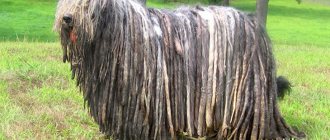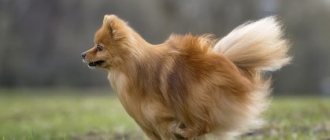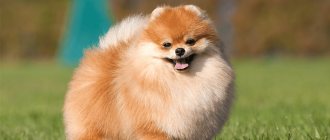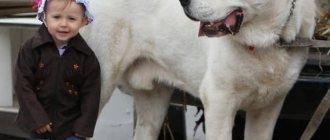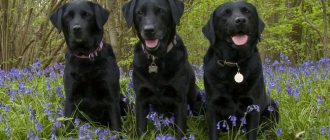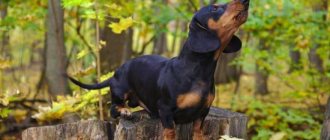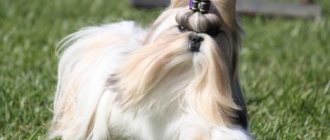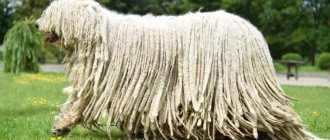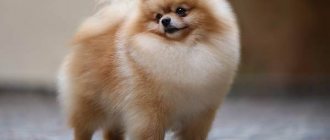Dogs have been faithful companions to humans for several tens of thousands of years, without which most of us simply cannot imagine our lives. Along with cats, dogs are the most common companion animals. Their breeds are so diverse that for quite a long time they have been numbered not in tens, but in hundreds. Every day, thousands of breeders work around the world to create newer and more unusual dog breeds. Did you know that some breeds are more common than others? And there are certain breeds that are completely rare. Today in our article, we will tell you about the 10 rarest dog breeds on the planet.
Pitbull Merle color
If you are suddenly stopped on the street and asked what breed of dog is considered the most dangerous, you will most likely answer without hesitation - pit bull terrier. Indeed, this dog does not have a very good reputation due to its complex character. Once upon a time, she was bred for dog fighting, which means she is more susceptible to aggression than dogs of other breeds. However, under conditions of strict discipline and regular training, a pit bull puppy will grow into a loyal, reliable and friendly companion. For quite a long time, in different countries of the world, the breeding of these dogs was prohibited, so they can be called rare. However, some pit bull terriers are considered rarer than their relatives. The differences lie in the color of the Merle, this is a special, very rare color in which uneven coloration of the coat is observed. Simply put, the dog was sprayed with dark paint to make it look spotted. Despite the fact that Merle-colored pit bulls look incredibly impressive, breeders are in no hurry to distribute them. Moreover, in certain professional circles, dogs of this color are even considered prohibited. The fact is that the process of pigment formation in a dog begins at the embryonic stage, at the same time when the nervous system is formed. Merle is, in fact, a genetic color defect, that is, at a certain stage of embryo development, a malfunction occurred, it spreads to all processes, so such dogs are almost always diagnosed with defects in the nervous system.
Kooyerhondje
Also known as the Small Dutch Water Hunting Dog, this dog is resistant to cold and wet conditions. His enthusiastic nature makes him an excellent catch. This is a very gentle dog, very attentive and especially not very noisy. It is then suitable for apartment living. He has a lively mind and is very easy to train because he quickly communicates with his surroundings. It is especially important to prioritize daily physical activity, especially outside of hunting season.
Catalburun
The unusual appearance of the dog, which we will now discuss, catches your eye as soon as you see it. At first it seems that there is simply something wrong with the dog, then upon closer examination you suddenly realize that the dog has two noses instead of one. Don't worry, Catalburun dogs are not victims of animal cruelty, they were just bred that way. All individuals of the breed have a forked nose, and in some dogs this feature is more pronounced, while in others it is less pronounced. An alternative name for the breed is “Turkish Pointer,” which means it is a hunting dog, it has a pronounced hunting instinct and sensitive sense of smell, and boasts high trainability. Despite the fact that the “Turkish Pointer” has very distinct external similarities with other pointers, the breed has not received recognition from the International Canine Federation. This is why there are very few breeders, which means the breed is considered rare.
Stabihon
The Stabihoun is a rare breed of hunting dog from the Netherlands. In Holland, stabihons were faithful companions of townspeople, hunters and farmers: loyal animals hunted, guarded houses and protected people. The ancestors are considered to be spaniels and the Drenthe partridge dog. Outside of Holland, stabychones are very rare.
The dog is balanced, calm, persistent in searching, has a guard and hunting instinct. Efficient, hardworking, loyal to her owners. Affectionate, suitable for families with children. In the event of an external threat, it comes to the defense of the house. It is unpretentious in care, but needs physical and intellectual stress.
Trains well with persistent, consistent repetitions. The coat is long, color: brown, black or red with white spots. She sheds twice a year. Use: hunter, watchman, companion. Height – up to 50 cm, weight – up to 27 kg.
Mexican hairless dog
An alternative name for the dog you see in the photo is Sholoitzcuintle, but we, with your permission, will not call it that and will limit ourselves to the simpler name “Mexican Hairless Dog” or Sholo. According to general data, this is one of the most ancient dog breeds in the world, and some sources claim that it is even the rarest on Earth. The Mexican Hairless Dog was bred in the 5th-3rd millennium BC, and it boasts an incredible history. The natives read Sholo as the earthly representative of the Aztec god of thunder and death, Xolotl, hence the name. It was believed that dogs were supposed to accompany the souls of the dead to the afterlife. Despite its ancient history, the dog breed, for unknown reasons, is practically not widespread in the world.
Criteria determining the rarity of a breed
Currently, there is no officially recognized list of factors that determine the rarity of a breed . However, there are a number of criteria that influence the list of small representatives of canids.
The rarity of the breed may be due to:
- extinction (extinction of a certain type of dog);
- difficulty of breeding (need for special conditions);
- high cost;
- a small number of representatives (limited selection of genetic material), etc.
There are more than 400 dog breeds on our planet, but only 344 breeds are officially registered in the most authoritative canine association FCI. About 40 breeds remain unrecognized and poorly studied.
Bergamasco Shepherd
When you look at a dog of the “Bergamasco” breed, it seems that there is no dog at all, in front of you there is only an impressive heap of fur. But no, the dog actually exists, you just need to try to see it. The homeland of these dogs is Italy, the province of Bergamo, as you might have guessed, the dog received its name in honor of the area where it was bred. The fact that such fluffy dogs were bred in a hot country may seem strange. However, Bergamasco Shepherds tolerate heat surprisingly well; they tolerate rain and cold even better and are not afraid of any weather at all. The shepherd dog was bred to help people herd sheep, so it is no coincidence that “Bergamasco” looks like a bunch of tangles of wool. A thick layer of fur not only adapts the dog to any weather conditions, but also protects it from the teeth of wolves. Bergamo Shepherds are not suitable for living in a house; today they are bred exclusively as herding dogs, that is, quite rarely.
9.Chongqing
Since 210 BC. e., these proud representatives of the dog tribe decorated the palaces of emperors and the houses of noble residents of China. The revolution of 1927–1950 put an end to the prosperity of Chongqing. Freedom fighters destroyed not only the rich, but also their pets. Today, the number of dogs in the Celestial Empire does not exceed 2,100 individuals, 2,000 of which can be found only in the territory of the PRC.
The exterior of the animals is unique. The small body, 30–45 cm high, is crowned by a large, wrinkled head with powerful jaws. Chungking people are serious and courageous creatures. Vigilant guards, they are wary of strangers, and at the slightest sign of aggression from a perceived enemy they rush to attack. Among their brethren, four-legged natives of China are known for their longevity - their average age varies from 17 to 20 years.
Tibetan mastiff
And here is another dog that is considered very, very ancient. The first mention of it can be found in documents of late antiquity, sometime in the last three or four centuries BC. These huge fluffy dogs guarded Tibetan monks and helped nomads in the Himalayan mountains. There is an opinion that it was from the Tibetan mastiffs that all herding and mastiff dogs originated. The weight of an adult dog can reach 60-80 kilograms, and the standard height at the withers is 60-77 centimeters. To support such a giant, you need to have your own house with a spacious yard. Their thick coat does not allow them to easily withstand hot and humid climatic conditions, so not everyone can have such a dog.
5. Otterhound
The roots of Otterhounds go back to the 12th century. It was at this time that large dogs appeared in Britain, used to hunt otters. In 1978, a law was passed in Foggy Albion banning otter fishing, and the popularity of shaggy hounds decreased significantly. Now four-legged hunters are used in baiting badgers, foxes and bears. There are about 1,000 individuals living in the world, most of which are concentrated in America.
The muscular body (height is from 60 to 70 cm) is covered with coarse fur, and the head is decorated with shaggy eyebrows. An unprepossessing appearance hides a tender and loving heart. Otterhounds cannot stand rudeness, they need the attention of their owner, but at the same time they are stubborn, willful and lack a sense of fear. These dogs need constant movement, so apartment living conditions are not suitable for them.
Thai Ridgeback
It is interesting that most of the rarest and most unusual dogs are also the most ancient. It’s as if people got too carried away with breeding dogs and gradually began to forget where it all began. Research shows that Thai Ridgebacks are very similar to the Dingo dog, meaning they are most likely quite closely related. By the way, scientists believe that today it is one of the most pristine and original breeds. Scientists still argue that the dogs were bred, but for quite a long time their distribution was limited to Thailand, Vietnam, Cambodia and Indonesia. In ancient times, this area was highly isolated due to poor transport connections, this whole situation led to the fact that Thai Ridgebacks were protected from crossing with other breeds. Despite the fact that the breed has ancient origins, it was registered by the International Canine Federation only in 1993, for this reason its distribution was limited.
Moody
It is assumed that dogs with wavy hair, whose height does not exceed 47 cm, first appeared in the early 17th century in the vastness of Hungary. The Magyars used their pets as skilled shepherds, brave rat exterminators and tireless companions on long walks. During World War II, these dogs almost completely disappeared. It was possible to save the livestock only thanks to a dozen miraculously surviving animals. Today there are about 2,000 individuals in the world.
Mudi are the real hard workers of the dog world. They enthusiastically carry out any assigned work. Energetic creatures take part in competitions with pleasure: frisbee dog, agility, coursing. Owners value Mudi for their cheerful disposition, intelligence, obedience and all-consuming loyalty.
Basenji
The history of this dog breed, which originated in central Africa, goes back more than five thousand years. Basenjis have quite a few unique features that make them impossible to confuse with other dogs. First of all, they can't bark. Yes, yes, this is really a dog that is not capable of barking in the usual sense of the word. Instead of barking, Basenjis make characteristic sounds like purring, but they can only be heard when the dog is excited. Secondly, when a dog pinches its ears on its forehead, it develops funny wrinkles, just like a human. Well, the last feature is the tightly curled tail. It may seem surprising, but Basenji dogs do not have the unpleasant odor that appears in all other breeds some time after bathing. Often a dog can be caught washing itself, exactly the same as cats do. Basenji wool is also considered hypoallergenic. It is worth mentioning that Basenji litters are very small; on average, 4-5 puppies are born; other dog breeds can produce up to 15 puppies at a time. Maybe this is the reason for their rarity?
Finnish Lapphund
The Finnish Lapphund was originally used by the semi-nomadic Sami people to work with reindeer herds. These days, this breed is a popular companion in its native Finland.
Intelligent, friendly and attentive, the Finnish Lapphund makes an excellent family companion and watchdog. Its activity requires daily exercise to maintain physical and mental development. Regular exercise will prevent your dog from becoming destructive or noisy in an attempt to entertain himself.
Azawakh
We warn you, once you convince an Azawakh dog, you will most likely be dying to feed it. However, it is not by chance that individuals have such abnormal thinness; the fact is that dogs of the Azawakh breed belong to the greyhound family. They were bred in Mali, a country with a very hot climate, most of it occupied by the Sahara Desert. It is logical that dogs in this region should have had a special structure, and this is how the Azawakh breed turned out. There is no excess fatty tissue on the body, the muscles are dry and flat, the skin is thin with a large number of blood vessels. All these qualities, coupled with long limbs and a short back, allow the dog to develop high speed, and in addition, provide endurance. The Azawakh is capable of chasing game for a long time, even in extreme heat. Dogs of this breed are not very sociable and cannot live in an apartment; they need regular physical activity, which is why it is not so common.
Norwegian Lundehund
A climbing dog from the northern coast of Norway, an Atlantic puffin hunter. The oldest breed, in the past - a vital assistant for the inhabitants of these harsh lands. The name of the breed is translated from Norwegian - “puffin hunter”. In the 19th century, this fishery acquired an industrial scale and the need for dogs disappeared.
By the middle of the 20th century, representatives of the breed remained only on the island of Vørøy - it was these animals, through the efforts of Norwegian breeders, that revived the population of the Norwegian Lundehund.
Expressive look of a dog of the Norwegian Lundehund breed
Norwegian Lundehund dog
Norwegian Lundehund frolicking in the snow
These dogs are small, very intelligent and energetic, with an obedient and independent character. However, the popularity of the breed is very low - there are no more than two thousand individuals worldwide, 500 of which live in Norway.
Catahoula Leopard Dog
Unfortunately, there is no information about how exactly a dog with such an unusual breed name appeared. The debate is still ongoing. Some believe that it was developed when native Indian dogs were crossed with red wolves, as well as dogs that were brought to the new world by the Spanish conquerors. Others deny the presence of wolf blood in the genes. Well, still others are sure that the Catahoula Leopard Dog is a cross between a wolf and a French Shepherd. In any case, the homeland of the dog is North America. In 1979, the Louisiana government even declared the breed the official symbol of the state. Initially, dogs were bred to hunt fur-bearing animals, as well as large animals such as elk, wild boar and bear. Today they are much more often used as herding dogs. It is interesting that outside the USA, it is almost impossible to find dogs of this breed; kennels are located in literally a couple of European countries.
Lyon Bichon
Bichons are not the rarest breed of small dogs, but the Lyon Bichon is a special case. In the 14th century, several dwarf dogs (descendants of mixed marriages of lapdogs, poodles or papillons) from France came to the island of Tenerife, where they began to develop as a separate breed. They were often cut like a lion, which became the reason for the new names - “Lyon Bichon” and “Löwchen”.
After World War II, the rare Lyon Bichon breed was on the verge of extinction, but English breeders literally revived it from a few individuals. Now most of the nurseries are located in France, from where several animals came to Russia.
Lyon Bichons are strong, compact representatives of the dwarf dogs. Their coat is long, wavy, and comes in any color: black, white, spotted, fawn. Whatever the color, the breed haircut of the Lyons is “lion”: a long mane and shaggy forelimbs, a tassel on the tail, the back half of the body is cropped. Pets are impressionable, emotional and cheerful, loyal and loving, and get along well with children. Used as companions. Height – 25-33 cm, weight 3.5-8 kg.
Bedlington Terrier
The homeland of the last dogs on our list is Great Britain. The first mention of it appeared approximately 200 years ago, although at that time the breed was called the Rothbury Terrier. They were bred on the border of England and Scotland and were used mainly for hunting. Closer to the 19th century, the popularity of the dog increased, and it was then that they acquired the refined and sophisticated appearance we are accustomed to today. Interestingly, at some point, the breeders clashed in confrontation. Some tried to preserve the hunting qualities of the breed. Others bred dogs with a gentle, easy-going nature so that they could be human companions. We cannot say who won this battle, but today the Bedlington Terrier is one of the most expensive and rare dog breeds; they are most popular in aristocratic circles.
Well, write in the comments which of these dogs you would like to buy? And if you were interested, then rate this article and register on the site. There will be even more interesting things to come.
What is your opinion?
Rate the article on a 5-point scale! ( 0 ratings, average: 0.0 out of 5)
Rottweiler
The Rottweiler is known for its strength, courage and power. It is intended primarily for security and protection
It is very important for him to feel respect from the owner. This dog often shows stubbornness and persistence.
He treats strangers with distrust. If the Rottweiler feels threatened by a person, he may become aggressive towards him. Such a pet needs to be constantly trained; it needs daily exercise.
The dog will be flexible, faithful and obedient only if it is raised correctly. Rottweilers are especially popular in Algeria, Angola, Armenia, Azerbaijan, Belize, Bolivia, Denmark, Estonia, Ethiopia, Finland, France, India, Iraq and many other countries.
The popularity of a particular dog breed is always determined by several factors. These are, first of all, features of appearance, certain qualities and character traits of animals. Sometimes a particular breed becomes popular after the release of an interesting film. For example, after the film “101 Dalmatians” was released, the demand for Dalmatians immediately increased sharply. The researchers also found that the popularity of a breed in a particular country depends on its climate and location.
Karelian Laika
The perky little redhead with a donut tail never loses his spirits – in all the photos these dogs are full of strength and energy.
Height: 43-50 cm - male; 38-45 cm - knot;
- Weight: 11.5-13 kg for males, the norm for females is within 7-10 kg;
- Lifespan: 10-12 years;
- Color: red of all shades;
- Coat: Medium length and dense, but set erect. The “lining” is soft and thick. An elongated “collar” is visible on the shoulders and neck.
Important! For all four-legged hunters without exception, early socialization is important - getting to know the family and other pets living nearby. In this breed, obedience coexists with pride, and independence with the need for regular communication. Even a couple of hours of solitude will mentally suppress such a dog.
Even a couple of hours of solitude will mentally suppress such a dog.
In this breed, obedience coexists with pride, and independence with the need for regular communication. Even a couple of hours of solitude will mentally suppress such a dog.
Its small size makes it possible to keep the “Karel” in an apartment (of course, with walks and jogging outside). A lively character and cheerful disposition turn training into a fun event, which sometimes has a bad effect on the results.
It has been noted that until approximately 3.5-4 years of age, these dogs perceive the owner as a guardian, so older animals are taken for hunting. The main targets are birds and ungulates, which are unlikely to escape from a nimble dog for whom weather conditions do not matter.
We have expanded our knowledge a little about what breeds of hunting dogs there are, and descriptions with photographs and exact names will help you remember them, as they say, “by sight.” We hope this data will help you decide on the right assistant. More new impressions!
